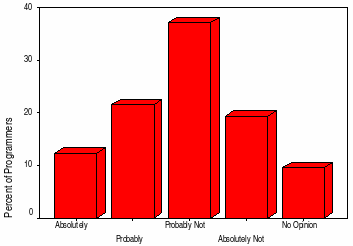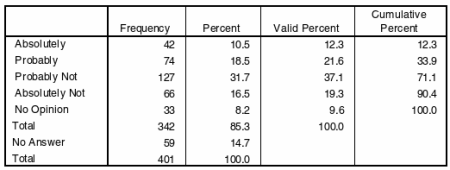Linux in the Mobile Space: Today and Tomorrow
Sep 7, 2006 — by LinuxDevices Staff — from the LinuxDevices Archive — viewsForeword — This EDC whitepaper was commissioned by PalmSource. It explores the progress and prospects of Linux in the mobile phone market, looking at major stack vendors, geographic trends, drivers, and inhibitors. It also includes research data from EDC's surveys of mobile application developers. Enjoy . . . !
by Albion M. Butters
August 2006
Overview
In a relatively short time the Linux platform has made significant strides within the wireless market. The goal of this report is to provide an overview of the current state of Linux in this space, some background on how it got there and a description of whom the major players are. Using recent data from Evan Data Corp's Wireless Development Survey and OSS/Linux Development Survey, this paper offers specific numbers on wireless Linux demographics and market share. It also focuses analysis on the advantages of using Linux, such as cost and improved flexibility, with a view toward the future of this emerging trend.
The Linux platform has been recognized as a viable Open Source alternative for a variety of computing environments. It comes as a natural progression that Linux would also make great strides in the mobile space. According to industry market figures, close to a quarter of all smart-phones sold last year were running Linux. This represents phenomenal growth over the past 24 months. And where there is IT growth, there will be developers.
Linux has already passed Palm, RIM, and BREW in terms of the overall percentage of wireless developers targeting those operating systems. In fact, over the past year the percentage of wireless developers targeting the Linux platform with their applications has risen from 24 percent to 37 percent. This is to say, from Spring 2005 to Spring 2006 there has been a 54 percent increase in Linux development in the mobile space. By all indications, growth is expected to continue: six out of ten wireless developers are optimistic about their use of Open Source or Linux tools next year.
Developers not only respond to market demand, but also drive the market with their innovation. Linux sparks enthusiasm with many developers because of the nature of Open Source, where code is transparent and technological advances are almost synergistic. Linux offers developers an Open Source alternative that is equal to or better than the proprietary platforms. Linux also offers novelty: generally speaking, the vast majority of Linux developers are engaged in writing new applications, not maintaining or extending legacy software. This is even more the case where Linux meets wireless.
Nor is the pattern of growth restricted to wireless developers moving to Linux. In the much larger developer community, many Linux developers are moving to wireless. These proponents of Open Source software are already familiar with the strength of Linux on the server side, where it can be deployed inexpensively and securely. The convergence of these two groups signals a potential groundswell of community. It also spells significant opportunities for vendors as they continue to improve and make available commercial-grade wireless Linux solutions.
Targeting of Wireless Platforms (Trend)
Linux has seen significant adoption over the last year, with 37 percent of wireless developers targeting today compared to only 24 percent twelve months ago. This trending chart reveals the 54 percent growth of Linux relative to the plateaus of other major platforms.
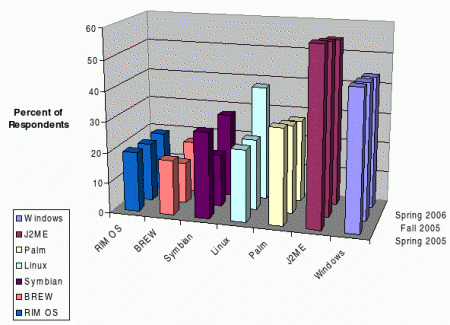
Target platform for wireless applications
(Click to enlarge)
Major Players
The Linux mobile market is comprised of a widening field of players, including manufacturers and software vendors. Some, like Motorola and PalmSource, a wholly owned subsidiary of ACCESS CO., LTD., have radically shifted their model to include Linux. Others have built their entire business around the platform (e.g., Trolltech). On the fringe are players like Nokia, who has dabbled with Linux but has yet to commit.
- ACCESS|PalmSource — In 2004, PalmSource acquired China MobileSoft in order to gain that company's optimized Linux OS. Last year PalmSource was itself acquired by Japan's ACCESS CO., LTD. Details of a new operating system platform from ACCESS and PalmSource, the Access Linux Platform (ALP), were released at 3GSM in February (2006). The first product announcement since PalmSource's acquisition, it clearly signals that company's continued focus on Open Source. Indeed, PalmSource is promising a complete solution (e.g., SDK that integrates kernel and UI and developer community) will be released to select licensees by the end of 2006. General availability is expected sometime in the first half of 2007. Looking forward, the ultimate goal is to facilitate commercial-grade Linux solutions for the mobile space. But PalmSource is also being careful to promise backwards compatibility for older Palm OS applications. If able to successfully leverage its 400k+ worldwide registered developer base to Linux, ACCESS and PalmSource will be in a clear place of strength.
- Motorola — Motorola first came to Linux for mobile devices in 2001 when four engineers needed to get a phone to recognize Chinese characters. Today Motorola is one of the strongest contenders in the mobile Linux space. In 2004, running embedded Linux software from MontaVista; the A780 was released to the U.S. for business users. In 2005, Motorola released no fewer than ten different Linux phones (including the A728 (cost-optimized), A732 (aimed at text message users), A910 (high-end with Wi-Fi) and E680i camera-phone with MP3 capability). In the first month of this year, they debuted the A1200 smart-phone in China (though it has already been registered in the U.S. with the FCC), upgraded the Rokr music-phone with the E2 model, and made significant improvements on the user interface of the Wi-Fi enabled A910 (in the face of widespread criticism over their Linux phones' UI). The decision of Motorola to abandon Symbian can be seen as a key marker in the overall market's adoption of Linux.
- Nokia — One of the best examples of how strong public demand is for Linux can be seen with the Nokia 770 Internet Tablet. First made available for purchase in November of last year, demand so exceeded supply that distributors were backlogged for months. The consumer market appears open after all to a wireless networked tablet-type device that allows for Internet browsing and email connectivity. The Nokia 770's operating system, called Maemo, is based on Debian Linux but promises extensibility for developers to use it as an applications framework. A recent update (OS 2006) now provides support for VoIP, but breaks backwards compatibility. Indeed, Nokia's overall attitude towards mobile Linux is complicated. On one hand the Finnish company is working to maintain good relations with the Linux community (e.g., its promise not to seek payment on any of its Linux patents that are infringed upon). On the other hand, with Linux biting directly into Symbian's market share, Nokia has stressed that all of its smart-phones will run the latter platform — for the time being, at least.
- Samsung — Samsung recently shipped a set of Linux-based phones to China (e.g., China Mobile, China Unicom). These phones have standard smart-phone features, but are also designed to be consumer-friendly style with the “slider” form factor and touch-screen functionality. Both of these Samsung devices run Korean embedded specialist Mizi Research's flexible Prizm stack on top of the Linux kernel. One of these phones, the SGH-i858, was submitted to the FCC last October. Last year, Samsung started using Linux with the Qtopia smart-phone (using Trolltech instead of Mizi Research). It should be noted that Samsung is also believed to be currently evaluating ACCESS and PalmSource's ALP platform.
- Trolltech — Trolltech is primary known for its Qt (pronounced “cute”) technology, which is used by a number of vendors (e.g., the Opera browser, Motorola, Google Earth, Adobe Photoshop Elements). One of the strengths of Qt is the size of its Open Source community, which runs in the hundreds of thousands. Along with the Norwegian company's successful IPO, the fact that Trolltech is providing the GUI for many Linux mobile phone manufacturers makes it an integral force in this space going forward.
- Other — NEC and Panasonic have a history of working together to bring Linux to devices sold by NTT DoCoMo, Japan's largest carrier and one of the first to play in the Linux mobile phone market (e.g., the Linux-based FOMA 3G handset). Texas Instruments has entered the Linux market with a mobile phone reference design for Linux embedded software. MontaVista continues to work with Motorola and other handset manufacturers, providing them with a commercial-grade Linux-based OS.
Linux Adoption in the Wireless Space
Wireless Linux Usage by Region
More than a third of all mobile developers writing wireless applications (38 percent) are targeting Linux. Aside from very minor variations it appears that developers across all regions are equally compelled to write applications for this market.
One reason why North America and APAC see slightly higher percentages is because respondents in those regions target six different platforms with their mobile applications (rather than the average of five seen in EMEA). Another reason for the size of North America's numbers is that the overall Linux developer community is larger in this region than in APAC and EMEA.
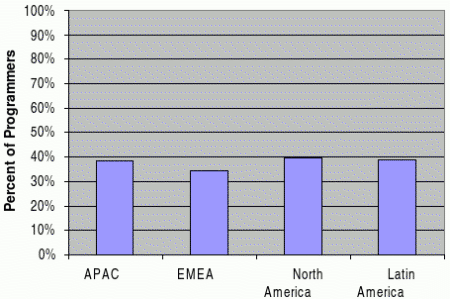
Linux targeting for wireless development (region)
(Click to enlarge)
Wireless Linux Usage by Developer Segment
The distribution of wireless developers targeting Linux has a greater proportion of applications being written by original equipment manufacturers and engineers working in the enterprise who are focused on filling the needs of small groups and individuals. Included within the OEM segment is any number of devices running Linux. Systems integrators and VARs are also likely to be involved in this area.
Comparatively speaking, ISVs and corporate-wide enterprise developers are less likely to be targeting the Linux platform with their wireless applications.
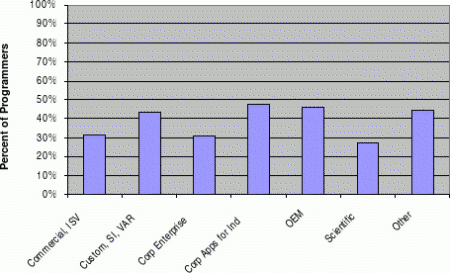
Linux targeting for wireless development (developer segment)
(Click to enlarge)
Number of OSS/Linux Developers doing Wireless Development
The overall Linux developer community currently stands at slightly more than three million worldwide. Of these, many are currently projecting development for wireless devices. Instead of asking wireless developers about their intentions towards Linux, this question mines the sentiment of OSS/Linux developers around wireless.
Here one finds that 12 percent of all respondents in Evans Data Corp.'s most recent OSS/Linux Development Survey are absolutely certain that they will be writing Linux applications for wireless devices over the next year. Another 22 percent are optimistic, making for a combined total of one in three developers in this demographic (34 percent) putting their sights on Linux.
Intent to develop Linux applications for wireless devices
(Click to enlarge)
“Are you likely to develop any Linux applications for handheld or wireless devices in the next year?”
Why Linux?
There are a number of factors that account for the success of Linux so far in the wireless market. Among these are technical features, cost considerations, developer affinities, and regional drivers.
This section explores specificities behind each of these elements.
Technical Drivers: Tools, Features and Benefits
“The strengths of Linux include stability, performance, security and flexibility.”
More than anything else, two things shape a typical developer's decision of what platform to work with: functionality and ease of use.
Linux offers those things. It is stable, secure and flexible with the transparency of its code. Some have argued that it is more ideal for embedded development than any other operating system. Developers like being able to see code and customize, but on devices requiring small memory footprints the issue can quickly become less about preferences and more about requirements.
Another advantage of running Linux on mobile devices is performance. This holds true both with rich-client and thin-client applications, but also below the application layer. For example, whereas some proprietary operating systems are very slow to boot up, handset manufacturers have been able to optimize Linux to start in less than fifteen seconds.
Some developers and carriers see advantages to the independence and open structure of Linux, instead of being tied to a single company (e.g., Windows Mobile with Microsoft or Symbian with Nokia). In fact, few respondents have specific objections to Linux. When asked about their willingness to work with Open Source in general, nearly two thirds of wireless developers (60 percent) are more than willing to use OSS tools as long as those tools have the functionality that they need.
The increasing complexity of rich application types on mobile devices, following in the wake of consumer expectation, is now putting developers on the spot to provide advanced functionality. It would be an understatement to cite the importance of good developer tools for this. Linux growth would not be possible without powerful tools — or a strong community, for that matter — but the platform appears to have reached a level of maturation where these things are very much a reality.
Inhibitors
Is all this to say that Linux is absolutely perfect or the most compelling platform offering for every developer? By no means. Developers are quite specific where Linux is strong and where it is weak in the mobile space. While Linux scores very well when it comes to platform performance, for instance, ranking much higher than Java ME and .NET Compact Framework, it currently has a need for improved hardware support. Developers also require better library resources for wireless development, a direct correlate to OSS' overall need to match the proprietary vendors' wealth of information. Marketing assistance is another place where Linux developers feel somewhat left out in the cold, especially compared to what they get with platforms like Symbian. Training is also a particularly weak spot for Linux, but this is not nearly as important an aspect as tool functionality and availability.
Some challenge the idea that the Linux community is cohesive and strong. Others complain about a lack of standards. While the former is more of a matter of interpretation, the latter point hits home. Fragmentation and interoperability issues do remain on the table. One type of fragmentation occurs when developers use different Linux distributions (not only Debian, Red Hat, and SUSE but also distributions specific to mobile devices). Competing Linux middleware and GUIs can also make for interoperability challenges. This type of fragmentation above the kernel is a more commonly heard criticism of Linux.
Fortunately, these challenges are being met. In the face of arguments that mass-market deployments of Linux phones depend more on interoperability than performance, one finds the Open Source Development Labs' (OSDL) Mobile Linux Initiative — led by Intel, BT, PalmSource, Motorola, MontaVista, Trolltech and Wind River — and Linux Phone Standards Forum (LiPS). The stated intent of the former organization is to reduce fragmentation of the Linux kernel, while the latter is more focused on the applications stack (i.e., standardized APIs and SDKs). To these two groups, one can also add the Consumer Electronics Linux Forum and the recently announced formation of yet another standards body (being formed by Samsung, NEC, NTT DoCoMo, Vodafone, Motorola and Panasonic). Though it remains to be seen how the existence of such disparate groups will unify developers on a single platform in the end, their common attention to functions like telephony, power management, improved boot time and footprint size should drive Linux towards greater overall maturation.
Cost
“A lower total cost of Linux ownership impacts the bottom line across the board.”
The cost advantages of Linux can be understood in different ways. Fundamentally, though, the lack of licensing fees for the OS provides relief for developers and carriers alike. A lower total cost of ownership impacts the bottom line across the board, improving profit margins and attracting new converts. For neophytes, Linux presents a low barrier to entry. Released from the onus of royalty payments, developers may find the freedom and feasibility to explore alternative new directions with code. Some even argue that the philosophy of code sharing makes for a stronger community.
It helps that this philosophy has also been taken up by the big names in Linux. One problem with OSS is that developers face the risk of discovering after the fact that they have written something that someone else has patented. To help mitigate against this, the Open Invention Network (OIN) was formed by IBM, Novell and others. It has won acclaim with its practice of acquiring patents and offering them for use royalty-free. This is a separate organization from the OSDL Patent Commons. It is also worth noting that Nokia specifically announced that they will not pursue their mobile Linux patents.
At the level of popular perception, Linux gains from the image of OSS being “free.” In fact, this perception is somewhat inaccurate. Because the kernel represents only a small percentage of the code needed to make a handset work, costs with tend to be rolled in with the application environments that run on top of it (e.g., Trolltech, Mizi). In some cases, developing or licensing Linux solutions can even be more costly than licensing a ready-made OS.
While in general the Open Source model provides the flexibility to accommodate a variety of business models, Linux developers need to trust that their support questions can be answered by the OSS community. In this ecosystem, one finds greater reliance on search engines and user groups. It is a different model than the developer program offered by proprietary vendors. With time, however, as well as continued growth of the installed code base and the Linux developer community, support should become less and less of an issue.
Region
- APAC — To date the vast majority of Linux phones have shipped in Asia. Yet different dynamics are apparent even within this region. For example, in Japan — the country where Linux phones are the most common — devices must meet the approval of a consumer market that is focused on features and functionality. As a matter of course, one finds Linux phones with Bluetooth radio, cameras that double as business card scanners, and mirrors below the camera lens to make it easier to take self-portraits. China has also seen strong adoption of mobile Linux, but for different reasons. On one hand, the low-end market segment is proving receptive to the reduced cost of Linux devices. On the other hand, there is a lot of investment in Linux at the development level. The government in particular has reasons to promote Linux over proprietary, closed platforms.
- EMEA — In Europe, where the adoption of Linux on wireless devices has followed the lead of Asian countries, another set of factors is in play. The primary difference with this region is that the move to Linux comes in response to the needs of operators. From a purely profit-based perspective, carriers who are competing with manufacturers by making their own self-branded phones stand to gain a better margin with the license-free Linux platform. Being able to customize their phones easily is also an important driver in their decision to go with Linux.
- North America — North America has perhaps been the slowest to react to Linux for wireless, partly because manufacturers have been slower to release devices here. But this is changing. Having realized that the modular nature of Linux allows for easier layering of features by demand, handset makers are discovering the improved bottom line of reduced development costs and starting to leverage these cost benefits across the domestic market. Regardless of whether or not the same level of feature functionality seen in Asia and Europe becomes immediately available in North America, it is expected that the Linux wave will reach the shores of the U.S. with much greater force over the next year. As noted above, North American developers are already as likely as their global counterparts to be planning Linux wireless application development over the next twelve months.
Future Outlook
“Approximately a third of wireless developers are absolutely certain that they will use Open Source or Linux tools next year (up from 21 percent six months ago).”
It is notoriously difficult to make forecasts in an area as volatile as wireless. Adoption of Linux to date has happened much faster than people expected, forcing some industry analysts to revise their projections of Linux on smart-phones. Most would agree — developers included — that the mobile Linux market will continue to grow within the next five years, particularly with smart-phones.
But how is this growth expected to occur? With the slowdown of growth in the overall mobile space, carriers and manufacturers are looking at providing “replacement” buyers with key differentiators. Linux is a nice option, particularly in terms of the flexibility it offers, but its success will depend on how well technological advances are actually executed. For manufacturers, the key is to make improvements with each successive phone (e.g., file system organization, Flash memory usage, user interfaces). Early adopters of Linux are clearly at an advantage here, but to stay ahead of the curve they will need to address how the strengths of Linux can be leveraged to their full advantage against the capability of 3G networks. Tightening profit margins will also force the issue of underlying development costs associated with Linux.
As more and more players come to the table with mobile Linux offerings, competition will become more intense. But as companies dedicate more and more resources to Linux and the acquisition of smaller companies who have successfully innovated in this area, the playing field is also expected to narrow. This eventual consolidation, along with how much attention is today being paid to standards, suggests that Linux will see increased interoperability. This is an extremely critical step, considering current criticisms that Linux implementations are fragmented above the kernel.
In order to penetrate the Western wireless markets Linux is also going to have to prove itself as reliable for network solutions as the proprietary vendors. Microsoft in particular has made it clear that they are committed to further expanding their presence in the area of smart-phones. As is the already the case in the server market, Linux and Microsoft are coming head to head in the wireless arena.
In a sense, the real question is not just about smart-phones but the larger mobile market. Linux developers have already shown that they can erode Symbian's dominant smart-phone position and handicap Microsoft's attempt to grow there. But smart-phones represent but a microcosm of the bigger wireless picture. If smart-phones are any indicator of where the overall mobile mass-market could be headed, the real showdown has yet to occur.
Vaunting Linux as the “operating system of the future”, manufacturers are doing everything that they can to facilitate the shift. Developers seem content to follow along. If anything, the number of wireless developers who expect to use Open Source software for mobile applications continues to grow. As mentioned above, 31 percent are absolutely certain that they will use Open Source or Linux tools next year (up from 21 percent six months ago) and six out of ten wireless respondents are generally optimistic. With such convergences, the future of Linux in mobile is brighter than ever.
Disclaimer and Other Notices
Evans Data Corp. (EDC) has made every effort to produce the highest quality research product in this series. The customer understands that EDC uses those statistical and data gathering techniques which, in its opinion, are the most accurate possible. However, inherent in any statistical inquiry is a possibility of error, which must be taken into account in evaluating the results. Evaluations and interpretations of statistical research findings and decisions based on them are solely the responsibility of the customer and not EDC. The conclusions, summaries and interpretations provided by EDC are based strictly on the analysis of the data gathered and are not to be construed as recommendations; therefore EDC neither warrants their viability or accuracy nor assumes responsibility for the success or failure of any customer actions subsequently taken. PalmSource, Inc., a wholly owned subsidiary of ACCESS CO., LTD., sponsored this White Paper.The content, including without limitation, descriptions of third party products, features, functions, specifications, release dates and programs and feature products is supplied “AS-IS” AND WITH NO EXPRESS OR IMPLIED WARRANTIES whatsoever made by ACCESS Co., Ltd. PalmSource, Inc. or its third party suppliers or licensees. Product features, functions, specifications, programs and the development thereof may be modified, deleted or discontinued and any release date may be modified or canceled, at any time and without prior notice, in ACCESS Co., Ltd's, PalmSource, Inc.'s or the applicable third party's sole discretion.
ACCESS is a trademark or registered trademark of ACCESS CO., LTD. in Japan and other countries. Palm OS, PalmSource and its related logo are trademarks or registered trademarks of Palm Trademark Holding Company and are licensed exclusively to PalmSource, Inc. These marks may not be used in connection with any product or service that does not belong to PalmSource, Inc. (except as expressly permitted by a license with PalmSource, Inc.), in any manner that is likely to cause confusion among customers, or in any manner that disparages or discredits PalmSource, Inc., its licensor, its subsidiaries or affiliates.
Linux is a registered trademark of Linus Torvalds
All other trademarks are the property of their respective owners.ACCESS Linux Platform, ALP, and GHost are codenames subject to change upon release of the final product without prior notice, in the sole discretion of ACCESS CO., LTD., PalmSource, Inc., or the applicable third party.
This whitepaper is copyright (c) 2006 Evans Data Corp. (EDC). All rights reserved. Reproduced by LinuxDevices.com with permission.
This article was originally published on LinuxDevices.com and has been donated to the open source community by QuinStreet Inc. Please visit LinuxToday.com for up-to-date news and articles about Linux and open source.
